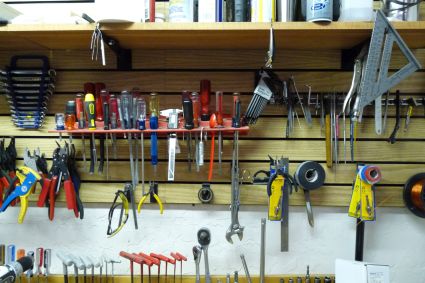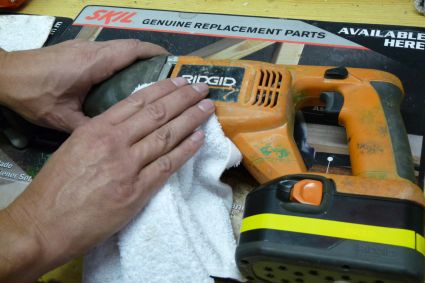1. Store tools in an area protected from the elements (like moisture).
2. Store tools in a clean and organized space.
3. Store tools in a well-ventilated area.

These suggestions almost go without saying.
Keeping tools out of the elements protects them from damage and wear. A clean and organized storage space will promote safety, and keeping tools well-ventilated will help them run smoothly when it's time to pull them out of storage.
It might take a little extra time to put everything back in place at the end of the day or completion of a project, but storing tools the right way will always be worth the effort.
[Back to top]
Care and Maintenance
Before being stored, most power tools can use a little cleaning and a couple of quick checks for damage or other problems. Here's some maintenance tips for keeping those tools in good shape:
- Use a toothbrush and a soft cloth to wipe debris from power tool casings before storage.

- If available, use an air compressor to clean out power tool vents. A little air will go a long way. When a machine or tool can breathe more, it will run cooler and wear more slowly. For an "Air Compressors 101" article-Click here.
- Lubricate power tool parts that need to be lubricated. Following instructions in the tool's user manual will help here.
- Check the parts that hold a tool together, screws, and other fasteners. Tighten up anything that might have been shaken loose during operation.
- Electrical cords should be checked with each use of a power tool. A bad power cord can be dangerous and should be replaced before the tool is used again. For more information about Power Cords-Click here.
- Keep blades and other cutting accessories sharp. Check bits and other accessories for wear and damage.
- Follow any other maintenance guidelines for a tool or machine explained in its user manual.
Some examples of parts that commonly need to be replaced on power tools are: carbon brushes, switch assemblies, power cords, accessories, bearings, and tires. Performing the checks and maintenance suggested in the section above is important for catching tool performance issues right when they start acting up. Making tool repairs at the first sign of performance trouble can prevent damage to other parts of a machine or tool. In order to provide tool users with the necessary resources, we at eReplacementParts.com offer services to our customers for getting to the bottom of tool and machine repair questions. For a "Diagnosing Guide" article-Click here. [Back to top] eReplacementParts.com Tool Repair Resources Because maintaining and repairing tools is vital for keeping good tools running, we want our customers to have the right "information tools" at their fingertips. We offer repair information and answers to our customers with the following services:
1. Repair Forums- Our tool repair forum is a great place to ask specific repair questions and get feedback from other industry professionals.
2. Discussion Boards- Our tool page discussion feature is also a perfect place to ask repair questions that are specific to a tool or machine.
3. "How-To" Articles- Many of our articles cover general repair information, questions, and issues. Specific articles are written to clear up confusing issues and common pitfalls for particular models. For more "How-To" articles-Click here.
4. Customer Service- We invite our customers to call our customer service department, located right here at our warehouse in Salt Lake Valley, UT. Our representatives are happy to research answers for any question. Contact us. Staying on top of power tool care and maintenance often means replacing parts and performing repairs. Good repairs start with the right tools for tool repair. For an article about Tools for Tool Repair--Click here. And you can also visit our Tools for Tool Repair page for a great selection of essential repair tools. [Back to top] What we're about.



















































